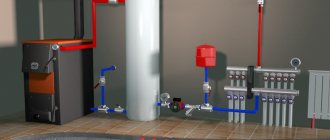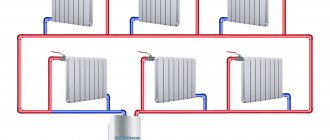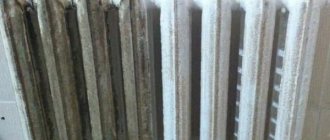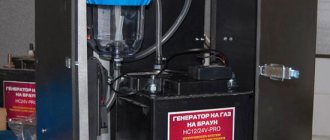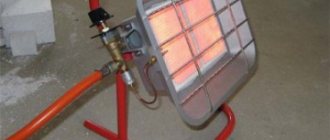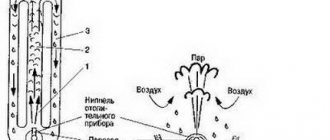Often, homeowners are unable to buy modern heating equipment, so they are looking for alternative solutions. Take, for example, a buffer tank (otherwise known as a heat accumulator), an indispensable item for heating systems with a solid fuel boiler. A storage tank with a volume of 500 liters costs approximately 600-700 USD. That is, the price of a thousand-liter barrel reaches 1000 USD. e. If you make a heat accumulator with your own hands, and then install the tank in the boiler room yourself, you will be able to save half of the specified amount. Our task is to talk about manufacturing methods.
Where is a heat accumulator used and how is it designed?
A thermal energy storage device is nothing more than an insulated iron tank with pipes for connecting water heating lines. The buffer tank performs 2 functions: it accumulates excess heat and heats the house during periods when the boiler is inactive. The heat accumulator replaces the heating unit in 2 cases:
- When heating a home with a stove with a water circuit or a boiler that burns solid fuel. The storage tank works for heating at night, after wood or coal burns out. Thanks to this, the homeowner can relax in peace, rather than running to the boiler room. It is comfortable.
- When the heat source is an electric boiler, and electricity consumption is recorded using a multi-tariff meter. Energy at the night rate is half the price, so during the day the heating system is completely powered by the heat accumulator. It's economical.
On the left in the photo is a 400 liter buffer tank from Drazice, on the right is a Kospel electric boiler complete with a hot water storage tank
Important point. Tank - hot water accumulator increases the efficiency of a solid fuel boiler. After all, the maximum efficiency of a heat generator is achieved with intense combustion, which cannot be constantly maintained without a buffer tank that absorbs excess heat. The more efficiently wood is burned, the less it is consumed. This also applies to a gas boiler, whose efficiency decreases in low combustion modes.
A storage tank filled with coolant operates on a simple principle. While the heat generator is heating the rooms, the water in the tank is heated to a maximum temperature of 80-90 ° C (the heat accumulator is charging). After the boiler is turned off, hot coolant from the storage tank begins to flow to the radiators, providing heating for the house for a certain time (the heat battery is discharged). The duration of operation depends on the volume of the tank and the outside air temperature.
How does a factory-made heat accumulator work?
The simplest factory-made storage tank for water, shown in the diagram, consists of the following elements:
- the main tank is cylindrical in shape, made of carbon or stainless steel;
- thermal insulation layer 50-100 mm thick, depending on the insulation used;
- outer skin – thin painted metal or polymer cover;
- connecting fittings embedded into the main container;
- immersion sleeves for installing a thermometer and pressure gauge.
Note. More expensive models of heat accumulators for heating systems are additionally equipped with coils for hot water supply and heating from solar collectors. Another useful option is a block of electric heating elements built into the upper zone of the tank.
Scope of application of the heat accumulator
Some people think that a heat accumulator is not particularly needed in the house, because it rarely works. However, the equipment plays an important role in the heating system and is used in several cases.
If the house is heated by a stove that has a water circuit, or by a boiler, which must be heated by adding firewood and coal. So that the owner of the house sleeps peacefully at night and does not run to the stove to add fuel, the heat accumulator starts working.
When the house is heated with an electric boiler, the electricity bill will be a considerable amount. Everyone knows that at night the tariff is half as much, so it is advisable to use a heat accumulator during the day.
And, of course, when the main heating source is turned off, for example, in the event of a breakdown, the thermal energy storage device will be very useful.
Factory production of heat storage devices
If you are seriously concerned about installing a heat accumulator and decide to make it yourself, then first you should familiarize yourself with the factory assembly technology.
Cutting blanks for the lid and bottom using a plasma machine
It is unrealistic to repeat the technological process in a home workshop, but some techniques will be useful to you. At the enterprise, the hot water storage tank is made in the form of a cylinder with a hemispherical bottom and a lid in the following order:
- Sheet metal 3 mm thick is fed to a plasma cutting machine, where it is used to produce blanks for end caps, housing, hatch and stand.
- The lathe produces main fittings with a diameter of 40 or 50 mm (1.5 and 2” thread) and immersion sleeves for control devices. A large flange for the inspection hatch, about 20 cm in size, is also machined there. A pipe for insertion into the body is welded to the latter.
- The body blank (the so-called shell) in the form of a sheet with holes for fittings is directed to rollers that bend it to a certain radius. To get a cylindrical container for water, all that remains is to butt weld the ends of the workpiece.
- A hydraulic press presses hemispherical caps from metal flat circles.
- The next operation is welding. The order is as follows: first, the body is welded using tacks, then the lids are tacked to it, then all the seams are completely welded. At the end, fittings and an inspection hatch are attached.
- The finished storage tank is welded to the stand, after which it undergoes 2 permeability tests - air and hydraulic. The latter is produced at a pressure of 8 bar, the test lasts 24 hours.
- The tested tank is painted and insulated with basalt fiber no less than 50 mm thick. The top of the container is sheathed with thin sheet steel with a colored polymer coating or covered with a thick cover.
The storage housing is bent from a sheet of iron on rollers
Reference. To insulate the tank, manufacturers use different materials. For example, Russian-made Prometheus heat accumulators are insulated with polyurethane foam.
Instead of cladding, manufacturers often use a special cover (you can choose the color).
Most factory-made heat accumulators are designed for a maximum pressure of 6 Bar at a coolant temperature in the heating system of 90 °C. This value is twice the response threshold of the safety valve installed on the safety group of solid fuel and gas boilers (limit - 3 Bar). The production process is shown in detail in the video:
How to connect
A person who has dealt with the construction of heating systems many times can easily make a heat accumulator with his own hands and make further connections. Such work should not be particularly difficult for a beginner.
In words, the connection diagram can be described as follows:
- A return pipeline must pass through the entire tank through the heat accumulator; a one and a half inch inlet and outlet must be provided at its ends
- First, the boiler return and the tank are connected to each other. Between them there should be a circulation pump that drives water from the barrel to the shut-off valve, expansion tank and heating device
- The circulation pump and shut-off valve are also mounted on the second side
- It is necessary to connect the supply pipeline by analogy with the previous one, but now heat pumps are not installed
It is worth noting that the heat accumulator is connected in a similar way to a heating system operating on the basis of just one boiler. If their number increases, the scheme will become significantly more complicated.
The container must be additionally equipped with a thermometer, pressure sensors inside and an explosion valve. By constantly accumulating heat, the barrel may overheat over time. To prevent an explosion, excess pressure must be released periodically.
Thermal accumulator and different types of heating systems
The heat accumulator can be installed together with various heating systems. By interacting with each of them, it provides a number of advantages and quickly pays for itself.
The most common are heat accumulators installed together with heating equipment running on solid fuel, in which the amount of residue is minimal. Having brought the efficiency to the maximum possible, they very quickly heat up the heating radiators, which soon wear out. It is better to save some of the generated energy and use it when the need really arises.
The double nightly tariff for electricity is a problem for owners of electric heating boilers. Thus, during the daytime, the heat accumulator will accumulate heat at a more favorable cost, and at night, it will release it to the heating system.
Similar installations are used in multi-circuit systems, distributing water between circuits. If you install pipes at different heights, you can select water at different temperatures.
Upgrade options
Looking at a simple heat accumulator with your own hands, a person with an engineering education will probably think about options for modernizing it. You can do this in the following ways:
- Another heat exchanger is installed below, through which the energy received by the solar collector can be accumulated
- You can divide the internal space of the tank into several sections communicating with each other so that the stratification of liquid by temperature is more pronounced
- Whether to spend money on thermal insulation or not - everyone decides for himself. But a few centimeters of polyurethane foam will significantly reduce heat loss
- By increasing the number of pipes, it will be possible to mount the installation to more complex heating systems with several circuits operating independently
- You can make an additional heat exchanger in which drinking water will accumulate
We make a heat battery ourselves
You have decided that you cannot do without a buffer tank and want to make it yourself. Then get ready to go through 5 stages:
- Calculation of the volume of the heat accumulator.
- Choosing a suitable design.
- Selection and preparation of materials.
- Assembly and leak testing.
- Installation of the tank and connection to the water heating system.
Advice. Before calculating the volume of the barrel, think about how much space in the boiler room you can allocate for it (in terms of area and height). Clearly decide how long the water heat accumulator should replace the inactive boiler, and only then proceed to the first stage.
How to calculate tank volume
There are 2 ways to calculate the capacity of a storage tank:
- simplified, offered by manufacturers;
- accurate, carried out according to the formula for the heat capacity of water.
The duration of heating a house with a heat accumulator depends on its size.
The essence of the enlarged calculation is simple: for each kW of boiler installation power, a volume equal to 25 liters of water is allocated in the tank. Example: if the productivity of the heat generator is 25 kW, then the minimum capacity of the heat accumulator will be 25 x 25 = 625 l or 0.625 m³. Now remember how much space is allocated in the boiler room and adjust the resulting volume to the actual size of the room.
Reference. Those who want to weld a homemade heat accumulator often wonder how to calculate the volume of a round barrel. Here it is worth recalling the formula for calculating the area of a circle: S = ¼πD². Substitute the diameter of the cylindrical tank (D) into it, and multiply the resulting result by the height of the tank.
You will get more accurate dimensions of the heat accumulator if you use the second method. After all, a simplified calculation will not show how long the calculated amount of coolant will last under the most unfavorable weather conditions. The proposed method is based on the indicators you need and is based on the formula:
m = Q / 1.163 x Δt
Here:
- Q – amount of heat that needs to be accumulated in the battery, kWh;
- m – estimated mass of coolant in the tank, tons;
- Δt – difference in water temperatures at the beginning and end of heating;
- 1.163 W•h/kg•°C is the reference heat capacity of water.
Let's explain further with an example. Let's take a standard house of 100 m² with an average heat consumption of 10 kW, where the boiler must be idle for 10 hours a day. Then it is necessary to accumulate 10 x 10 = 100 kWh of energy in the barrel. The initial water temperature in the heating network is 20 °C, heating occurs up to 90 °C. We calculate the mass of the coolant:
m = 100 / 1.163 x (90 - 20) = 1.22 tons, which is approximately 1.25 m³.
Please note that a heat load of 10 kW is taken approximately; in an insulated building with an area of 100 m², heat loss will be less. Point two: so much heat is needed on the coldest days, of which there are 5 for the whole winter. That is, a heat accumulator for 1000 liters is sufficient with a large margin, and taking into account the seasonal temperature difference, you can easily keep within 750 liters.
Hence the conclusion: in the formula you need to substitute the average heat consumption for the cold period, equal to half of the maximum:
m = 50 / 1.163 x (90 - 20) = 0.61 tons or 0.65 m³.
Note. If you calculate the volume of the barrel based on the average heat consumption, in severe frosts it will not be enough for the calculated period of time (in our example - 10 hours). But you will save money and space in the furnace room. More information on making payments is presented in our other publication.
About the design of the container
To make your own heat accumulator, you will have to defeat one insidious enemy - the pressure exerted by the liquid on the walls of the vessel. Do you think why factory tanks are made cylindrical, and the bottom and lid are hemispherical? Yes, because such a container can withstand the pressure of hot water without additional reinforcement.
On the other hand, few people have the technical ability to form metal on rollers, not to mention drawing semicircular parts. We offer the following ways to resolve the issue:
- Order a round internal tank from a metalworking enterprise, and carry out the insulation and final installation work yourself. It will still cost less than buying a factory-assembled heat accumulator.
- Take a ready-made cylindrical tank and make a buffer tank on its base. We will tell you where to get such tanks in the next section.
- Weld a rectangular heat accumulator from sheet iron and strengthen its walls.
Sectional drawing of a rectangular heat accumulator with a volume of 500 l
Advice. In a closed heating system with a solid fuel boiler, where excess pressure can jump to 3 Bar or higher, it is strongly recommended to use a cylindrical heat accumulator.
In an open heating system with zero water pressure, you can use a rectangular tank. But do not forget about the hydrostatic pressure of the coolant on the walls; add to it the height of the water column from the container to the expansion tank installed at the highest point. That is why the flat walls of a homemade heat accumulator should be reinforced, as shown in the drawing of a 500 liter capacity tank.
A properly reinforced rectangular storage tank can also be used in a closed heating system. But in the event of an emergency pressure surge from overheating of the TT boiler, the tank will leak with a 90% probability, although you may not notice a small crack under the insulation layer. Watch the video to see how the unstrengthened metal of the vessel bulges when filled with water:
Reference. It makes no sense to weld directly onto the walls stiffeners made of corners, channels and other rolled metal. Practice shows that the pressure force bends corners of a small section along with the wall, and tears off large ones at the edges.
Making a powerful frame from the outside is impractical, the consumption of materials is too high. A compromise option is the internal spacers shown in the drawing of a homemade heat accumulator.
Drawing of a 500 l heat accumulator - top view (cross section)
Selection of materials for the tank
You will make your task much easier if you find a ready-made cylindrical tank, initially designed for a pressure of 3–6 bar. What containers can be used:
- propane cylinders of different capacities;
- discarded process tanks, for example, receivers from industrial compressors;
- receivers from railway cars;
- old iron boilers;
- internal tanks of containers for storing liquid nitrogen, made of stainless steel.
It is much easier to make a reliable heat accumulator from ready-made steel vessels
Note. In extreme cases, a steel pipe of suitable diameter will do. Flat covers can be welded to it, which will have to be reinforced with internal braces.
To weld a square tank, take sheet metal 3 mm thick, no more is needed. Make rigidities from round pipes Ø15-20 mm or profiles 20 x 20 mm. Select the size of the fittings according to the diameter of the boiler outlet pipes, and for cladding, buy thin steel (0.3-0.5 mm) with powder painting.
A separate question is how to insulate a heat accumulator that you welded yourself. The best option is basalt wool in rolls with a density of up to 60 kg/m³ and a thickness of 60-80 mm. Polymers such as polystyrene foam or extruded polystyrene foam should not be used. The reason is mice that love warmth and in the fall can easily settle under the lining of your storage tank. Unlike polymer insulation, they do not chew basalt fiber.
Don't have any illusions about extruded polystyrene foam, rodents eat it too
Now we will indicate other options for ready-made vessels that are not recommended for use for heat accumulators:
- An improvised tank made from a Eurocube. Such plastic containers are designed for a maximum content temperature of 70 °C, but we need 90 °C.
- Heat accumulator made of an iron barrel. Contraindications: thin metal and flat tank lids. Instead of strengthening such a barrel, it is easier to take a good steel pipe.
Assembly of a rectangular heat accumulator
We would like to warn you right away: if you have mediocre welding skills, then it is better to order the manufacture of the tank externally according to your drawings. The quality and tightness of the seams is of great importance; at the slightest leak, the storage container will leak.
First, the tank is assembled using tacks, and then welded with a continuous seam
For a good welder there will be no problems here, you just need to understand the order of operations:
- Cut metal blanks to size and weld the body without a bottom and a lid using tacks. To secure the sheets, use clamps and a square.
- Cut holes in the side walls for the stiffeners. Insert the prepared pipes inside and scald their ends from the outside.
- Grab the bottom and lid to the tank. Cut holes in them and repeat the operation with the installation of internal braces.
- When all the opposite walls of the container are securely connected to each other, begin continuous welding of all seams.
- Install supports from pipe sections at the bottom of the tank.
- Insert the fittings at a distance of less than 10 cm from the bottom and lid, as shown in the photo below.
- Weld metal brackets to the walls, which will serve as brackets for attaching the insulating material and sheathing.
The photo shows a stretch made from a wide strip, but it is better to use a pipe
Advice on installing internal struts. To ensure that the walls of the heat accumulator effectively resist bending and do not break due to welding, extend the ends of the stretch marks outward by 50 mm. Then additionally weld stiffeners from a steel sheet or strip to them. Don’t worry about the appearance; the ends of the pipes will then be hidden under the cladding.
Steel brackets (clips) are welded to the body to secure the insulation and sheathing.
A few words about how to insulate a heat accumulator. First, check it for leaks by filling it with water or lubricating all the seams with kerosene. Thermal insulation is quite simple:
- clean and degrease all surfaces, apply primer and paint to protect them from corrosion;
- wrap the tank with insulation without squeezing it, and then secure it with a cord;
- cut the facing metal, make holes in it for the pipes;
- Screw the casing to the brackets with self-tapping screws.
Screw the cladding sheets so that they are connected to each other with fasteners. This completes the production of a homemade heat accumulator for an open heating system.
Installation and connection of the tank to heating
If the volume of your heat accumulator exceeds 500 liters, then it is not advisable to place it on a concrete floor; it is better to arrange a separate foundation. To do this, dismantle the screed and dig a hole to a dense layer of soil. Then fill it with broken stone (rubble), compact it and fill it with liquid clay. Pour a 150 mm thick reinforced concrete slab in wooden formwork on top.
Scheme of the foundation for the battery tank
The correct operation of a heat accumulator is based on the horizontal movement of hot and cooled flow inside the tank when the battery is “charging”, and the vertical flow of water during “discharging”. To organize such battery operation, you need to perform the following steps:
- the circuit of a solid fuel or other boiler is connected to a water storage tank through a circulation pump;
- the heating system is supplied with coolant using a separate pump and mixing unit with a three-way valve, which allows you to withdraw the required amount of water from the battery;
- the pump installed in the boiler circuit should not be inferior in performance to the unit supplying coolant to the heating devices.
Tank-heat accumulator wiring diagram
The standard connection diagram for a heat accumulator with a TT boiler is shown above in the figure. The balancing valve on the return line serves to regulate the coolant flow based on the water temperature at the inlet and outlet of the tank. Our expert Vladimir Sukhorukov will tell you how to properly strap and set up in his video:
Reference. If you live in the capital of the Russian Federation or the Moscow region, then regarding the connection of any heat accumulators, you can consult personally with Vladimir, using the contact information on his official website.
How to insulate a heat accumulator
Even when the tank is in a warm room, the temperature difference between the air and the coolant is too large - from 50 to 70 ºС. In order not to lose heat and not heat the furnace room with it, it is necessary to insulate the heat accumulator. The easiest way to do this is using foam plastic with a thickness of 100 mm and a density of 25 kg/m3. It is easy to glue it to metal walls and cut holes for pipes.
Mineral wool of the same thickness is also suitable for insulation, although it is somewhat more difficult to attach. The density of the material is 135-145 kg/m3. For round tanks made from barrels, you will have to use roll insulation like ISOVER; here you will have to tinker a lot with the fasteners, especially in the lower part of the tank.
The video below shows the installation and diagram of the heat accumulator with its connection to the boiler and heating system:
Article on the topic: How to make heating in a private house - a detailed guide
Budget storage tank made from cylinders
For those homeowners whose boiler room area is very limited, we suggest making a cylindrical heat accumulator from propane cylinders.
Homemade heat storage device paired with a TT boiler
The 100 liter design, developed by another of our masters, expert Vitaly Dashko, is designed to perform 3 functions:
- unload the solid fuel boiler when overheating, taking in excess heat;
- heat water for household needs;
- provide heating of the house for 1-2 hours in case of extinguishing of the TT boiler.
Note. The battery life of the heat accumulator is short due to its small volume. But it will fit in any furnace room and will be able to remove heat from the boiler after a power outage, since it is connected directly, without a pump.
This is what a tank made from cylinders looks like without lining.
To assemble a storage tank you will need:
- 2 standard propane cylinders;
- at least 10 m of copper tube Ø12 mm or stainless corrugation of the same diameter;
- fittings and sleeves for thermometers;
- insulation – basalt wool;
- painted metal for cladding.
You need to unscrew the valves from the cylinders and cut off the caps with a grinder, filling them with water to prevent the remaining gas from exploding. We carefully bend the copper tube into a coil around another pipe of a suitable diameter. Then we proceed like this:
- Using the presented drawing, drill holes in the future heat accumulator for pipes and sleeves for thermometers.
- Secure by welding several metal brackets inside the cylinders for mounting the DHW heat exchanger.
- Place the cylinders one on top of the other and weld them together.
- Install a coil inside the resulting tank, releasing the ends of the tube through the holes. Use gland packing to seal these areas.
- Attach the bottom and lid.
- Insert an air vent into the lid and a drain valve into the bottom.
- Weld the brackets to secure the casing. Make them different lengths so that the finished product has a rectangular shape. It will be inconvenient to bend the cladding in a semicircle, and it will not be aesthetically pleasing.
- Insulate the tank and fasten the casing with self-tapping screws.
Connecting the tank to a TT boiler without a circulation pump
The design feature of this heat accumulator is that it is connected to a solid fuel boiler directly, without a circulation pump. Therefore, for joining, steel pipes Ø50 mm are used, laid with a slope, the coolant circulates by gravity. To supply water to the heating radiators, a pump + three-way mixing valve is installed after the buffer tank.
